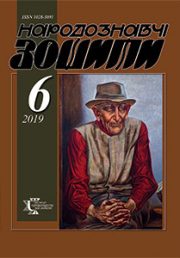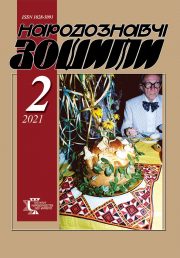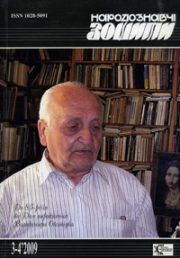The Ethnology Notebooks. 2023. № 3 (171), 597—606
UDK [398.332.416:398.47](=161.2)
DOI https://doi.org/10.15407/nz2023.03.597
PYROMANTIC ACTIVITIES ON HOLY EVE RITUALS OF UKRAINIANS
SEREBRYAKOVA Olena
- ORCID ID: https://orcid.org/0000-0002-1039-2920
- Ph.D. in history, senior researcher,
- The Ethnology Institute
- of the National Academy of Sciences of Ukraine,
- Department of Modern Ethnology,
- 15, Svobody Avenue, 79000, Lviv, Ukraine,
- Contacts: e-mail: o-sereb@ukr.net
Abstract. Folk divination is an important component of the ancient and traditional culture of Ukrainians in particular of calendar ritualism.
The aim of the offered article is coverage of the layer of customs and rituals, worldview phenomena associated to divination by candle on Holy Eve.
The object of the research is the traditional worldview, the customs and rite culture of the residents of different regions of Ukraine, and the subject — mantic ritual actions with a candle based on the observation of the «behavior» of smoke and fire, which Ukrainians resorted to on Holy Eve. Local beliefs and omens related to the prediction of life cycle events, harvest and weather are characterized.
The basis of the article are the materials of the field research, local folklore articles and works of the twenty and the beginning of the twenty-first centuries.
The methodology of this work is based on general scientific methodological principles and the basic requirements that apply to the works of historical and ethnological direction. The author uses a various methods (field observation, comparative-historical, comparative, reconstructive, structural-semantic).
Attention was paid to the method of performing divination and the composition of their executors. In the process of divination, the direction of smoke from an extinguished candle, its burning etc. was observed. With the help of pyromantic rites on Holy Eve, residents of different regions of Ukraine, in some places even now, learn about various events of a person’s life cycle (weddings, baptisms, the life or death of someone from the family). Interpreting certain omens, they also tried to predict how successful the harvest would be, to forecast the weather. We note the wide range of living, the same functionality, the same motivations of divination, which are based on the interpretation of certain analogies, semantic oppositions, symbolism, etc. In this context, mythologically marked places are important, which were associated with the location and connection to the «other» world of the souls of ancestors, household spirits, etc. The original interpretations of the results of fortune-telling with smoke, taboos on extinguishing candles, various omens, etc. can be attributed to the original phenomena that testify to the originality of ritual traditions of residents of different regions of Ukraine. Let’s note the long existence of many ancient beliefs, pyromantic customs and their partial preservation in modern times.
Keywords: mantic actions/practices (divination), Ukrainians, candle, smoke, life, death, marriage, baptism, harvest.
Received 6.04.2023
REFERENCES
- Moszynski, K. (1967). Divination. Folk culture of the Slavs. Spiritual culture (Vol. II, pp. 365—416). Warszawa [in Polish].
- Sumtsov, N. (1890, january). Cultural experiences. Kievskaja starina (Vol. 28, book 1, pp. 60—90) [in Russian].
- Biegeleisen, H. (1929). Near the cradle. In front of the altar. Above the grave. Lwow: Nakladem Instytutu Stauropigjanskiego [in Polish].
- Vadym, K.(1938). Divination of birds. Zhyttia i znannia, 7—8, 219—220 [in Ukrainian].
- Mykhajlets’kyj, O. (1912). Funeral customs and rites in the village Trostyantsi, Snyatinsky district. In Hnatiuk, V. Pokhoronni zvychai j obriady: Etnohrafichnyj zbirnyk (Vol. 32, pp. 302—315). Lviv [in Ukrainian].
- Voloshyns’kyj, I. (1919). Funeral customs and mourning in Horoden region. Materiialy do ukrains’koi etnolohii (Vol. ХІХ—ХХ, pp. 194—213). Lviv [in Ukrainian].
- Pan’kevych, I. (1929). Christmas customs and beliefs among Rusyns in Subcarpathia. Podkarpatska Rus’ (Vol. 2, pp. 43—47). Uzhhorod [in Ukrainian].
- Falkowski, J., & Pasznycki, B. (1935). On the border between Lemko and Boyko. Lwow [in Polish].
- Buhera, I. (1939). Customs and beliefs of Lemko’s region, 15. Lviv: Nash Lemko [in Ukrainian].
- Archive of the Institute of Ethnology of the National Academy of Sciences of Ukraine (then —Archive of the IN NANU). F. 1. Op. 2. Od. save 228 [in Ukrainian].
- Archive of the IN NANU. F. 1. Op. 2. Od. save 317 [in Ukrainian].
- Archive of the IN NANU. F. 1. Op. 2. Od. save 393 [in Ukrainian].
- Hromova, N. (2006). Holy evening in the modern village in Boyko’s region. Ethnic history of the peoples of Europe: a collection of scientific papers (Issue 21, pp. 89—96). Kyiv [in Ukrainian].
- Scientific archive of the Department of Ethnology and Local History, Faculty of History, Taras Shevchenko KNU. F. 3. Customs and ceremonies. P. 3. Christmas rituals of the boykos of the Lviv region, v. Oryavchyk of Skolivsky district. (Field materials of Gromova N. O.). Unit coll. 48 [in Ukrainian].
- Serebriakova, O. (2008). Pyromancy in calendar rites (customs and beliefs of Ukrainians of the Carpathians). Istoriia relihij v Ukraini. Naukovyj schorichnyk (Book I, pp. 128—134). Lviv: Lohos [in Ukrainian].
- Archive of the IN NANU. F. 1. Op. 2. Od. save 565 [in Ukrainian].
- Archive of the IN NANU. F. 1. Op. 2. Od. save 588 [in Ukrainian].
- Archive of the IN NANU. F. 1. Op. 2. Od. save 590 [in Ukrainian].
- Archive of the IN NANU. F. 1. Op. 2. Od. save 608 [in Ukrainian].
- Archive of the IN NANU. F. 1. Op. 2. Od. save 609 [in Ukrainian].
- Archive of the IN NANU. F. 1. Op. 2. Od. save 663 [in Ukrainian].
- Archive of the IN NANU. F. 1. Op. 2. Od. save 704 [in Ukrainian].
- Archive of the IN NANU. F. 1. Op. 2. Od. save 771 [in Ukrainian].
- Archive of the IN NANU. F. 1. Op. 2. Od. save 782 [in Ukrainian].
- Archive of the IN NANU. F. 1. Op. 2. Od. save 787 [in Ukrainian].
- Hajova, Ye. (2011). The philosophy of life in winter rites and customs of the Lemko’s (Christmas, Basil, «Grannie’s Holy Evening», John the Baptist, holiday meeting of winter and spring) on expedition materials collected in the Velykoberezniansky district of the Transcarpathian region. Calendar ritualism in the vital functions of ethnos. Collection of scientific works: is materials of the International scientific conference the «Odesa ethnographic readings» (Pp. 65—75). Odesa [in Ukrainian].
- Archive of the IN NANU. F. 1. Op. 2. Od. save 659 [in Ukrainian].
- Movna, U. (2014). Ukrainian Christmas and Epiphany ritual text: wax candle. The Ethnology notebooks, 2 (116), 236—249 [in Ukrainian].
- Hlushko, M. (2016). The Christmas Eve traditional customs and rites of the Ukrainians of Nadsiannia. The Ethnology notebooks, 6 (132), 1320—1330 [in Ukrainian].
- Zborovs’kyj, P. (2017). The Christmas cycle of holidays in Turka region (from the magazine «Music»). Z vershyn i nyzyn. Visnyk konkursu im. Myrona Utryska (Pp. 122—133). Turka [in Ukrainian].
- Yurijchuk, M., & Tkachenko, V. (2020). Christmas and Epiphany rites in South-Western Podillya (to the ethnographic image of modern Ukraine). Pereyaslavіca: Scientific notes of the National Historical and Ethnographic Reserve «Pereyaslav»: collection of scientific articles. Pereiaslav; Kam’ianets’-Podil’s’kyj: Drukarnia Ruta (Issue 17 (19), pp. 171—177) [in Ukrainian].
- Vynohradova, L.N., Tolstaia, S.M. & Tolstoj, N.I. (Ed.). (1999). Door. Slavic antiquities: an ethnolinguistic dictionary: in 5 vol. (Vol. 2: D—K (Crumbs), pp. 25—29). Moskva: Mezhdunarodnyje otnoshenija [in Russian].
- Skrypnyk, H. (Ed.). (2016). Ethnographic image of modern Ukraine. Corps of expeditionary folklore and ethnographic materials. Calendar rituals (Vol. 6). NAN Ukrainy; IMFE named after M. T. Rylsky. Kyiv [in Ukrainian].
- Kmit, Yu. (1935). More about village Volosatyj. Litopys Bojkivschyny (Vol. 6, pp. 1—9). Sambir [in Ukrainian].
- Matejka, Y. (1930). Christmas beliefs and customs of Volosyanka village. Podkarpatska Rus’ (Vol. 1—2, pp. 20—21). Uzhhorod [in Ukrainian].
- Majchyk, I., & Tsupryk, M. (1999). Odrekhova in the past 1419—1999. Lviv: Kameniar [in Ukrainian].
- Resheto, V. (1960). Some customs before Christmas. Nashe slovo, 52, 7[in Ukrainian].
- Reinfuss, R. (1990). In the footsteps of Lemkos. Warszawa: Kraj [in Polish].
- (1934). Christmas customs in Lemko’s region. Zhinocha dolia (Part 1, pp. 2). Kolomyia [in Ukrainian].
- Perejma, T. (1912). Funeral customs and rites in the village of Ropytsy Ruska, Horlytsky district. In Hnatiuk, V. Pokhoronni zvychai j obriady: Etnohrafichnyj zbirnyk (Vol. 32, pp. 203—209) Lviv [in Ukrainian].
- Mysevych, O. (1938). Christmas customs and songs from the village of Veremin, forest district. Litopys Bojkivschyny (Vol. 10, pp. 49—55). Sambir [in Ukrainian].
- Dobrians’ka I. (1964). Essays on the material and spiritual culture of the Lemkos. Nashe slovo, 24, 5 [in Ukrainian].
- Tkhir, L. (1989). Christmas customs in Yavirnik. Lemkivschyna, 4 (43), 4—7 [in Ukrainian].
- Khomyk, V. (1962). Holy evening in Lemko’s region. Nashe slovo, 1, 5[in Ukrainian].
- Khomyk, V. (1963). Lemko’s customs and rites. Nashe slovo, 19, 5[in Ukrainian].
- Archive of the IN NANU. F. 1. Op. 2. Od. save 285 [in Ukrainian].
- Makovij, H. P. (1993). Trampled flower: Folklore stories. Kyiv: Ukr. pys’mennyk [in Ukrainian].
- Zoshak, M. (1937). Holy Evening and folk beliefs. Nash lemko, 1, 10 [in Ukrainian].
- Ivanov, P. (1907). Life and beliefs of the peasants of the Kupyansk district, Kharkiv province. Sbornik Har’kovskogo istoriko-filologicheskogo obshhestva (Vol. 17). Kharkov: Pechatnoye Delo [in Russian].







